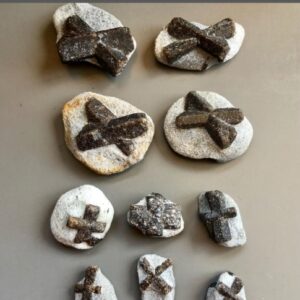“Staurolite” comes from the Greek word “Stauros” and means “Cross.” This mineral frequently occurs as twinned, six-sided crystals that occasionally intersect at 90-degree angles to form crosses. However, an intersecting angle of 60 degrees is far more common. In some localities, these natural twinned crystals are found, made into jewelry, and sold as Fairy Crosses.
Fairy Crosses
Fairy Crosses or Fairy Stones are small bricks that originally formed seven miles beneath the Earth of the Blue Ridge Mountains. Stauralites form into tiny bricks that twist in 60-degree or 90-degree angles under pressure, which creates crosses. As the stones push their way up to the Earth’s surface, the wind and rain dissolve the softer surrounding Schist stone, revealing the beautiful cross-shaped minerals within.
Finding Fairy Stones is easiest after heavy rain. You only have to dig with your hands along road cuts and embankments to find them. The stones are the same color as the dirt surrounding them, so sift through the soil until you find a cross-shaped stone about the size of a marble. They make excellent and interesting keepsakes and can be polished and used in jewelry making or as a pocket token.
How Are Fairy Stones Formed?
Staurolites or Fairy Stones are composed of aluminum, iron, and silicate. Like many other minerals, Staurolite forms in regular crystals.
Single crystals are hexagonal or six-sided; single stones often intersect at right angles, forming the Maltese or Roman shape. In other instances, the single stones intersect at 45-degree angles, forming St. Andrews crosses.
The formation of Fairy Stones or Staurolite crystals involved a precise combination of pressure and heat, which was provided by the crumpling and folding of the Earth’s crust during the formation of the Appalachian Mountains. This is why these stones are found in the Blue Ridge Mountains. During the formation of these interesting stones, mineral deposits surrounding the crystals were also subjected to the same conditions, resulting in Schist’s formation.
The Staurolites are usually harder than the surrounding Schist and less easily impacted by weathering. As the Staurolite-bearing Schist becomes weathered away, the more resistant stones are uncovered, being found exposed at the Earth’s surface. Sometimes, Staurolite can be found embedded in its Schist matrix as well.

Staurolite Schist
Staurolite minerals are commonly found in metamorphic rocks like Gneiss and Schist. Staurolite forms when shale is strongly altered by regional metamorphism and it’s not uncommon to find other minerals alongside Staurolites like Almandine Garnet, Kyanite, and Muscovite.
Cleaning Staurolites
There are two primary methods used to clean away excess matrix from Staurolite. With this type of stone, you’ll want to use a Dremel or Foredom tool.
I’ve heard of people using a chisel or even a sandblaster but you can’t beat the handheld Dremel option.
If you’re dealing with a large piece of matrix and the Fairy Cross is buried in the middle of it then you should probably start with a small chisel and a hammer. Once you get closer to the gemstone you’ll want to switch over to something that removes less material to ensure you don’t damage the Staurolite.
It’s generally a good idea to chip away most of the matrix but leave enough behind it for support. The cool thing about the matrix and Staurolite crystal is the contrast in colors. The lighter matrix makes the Fairy Crosses stand out.
Using a sandblaster to blast a specimen is another good option for removing the Mica Schist matrix. Glass beads are the preferred medium with this method since they lack the hardness to scratch the Staurolite but have enough to remove the host rock.
Be mindful and careful if you choose to use alternative blasting mediums aside from the glass beads, as many of them will cause damage to the Staurolite’s exterior.
Because chemical methods are ineffective for removing mica, anything you can’t get through sandblasting or with a chisel will require nothing more than elbow grease. While the mica can’t be dissolved, leaving behind an intact Staurolite, household hydrogen peroxide, and a wire brush can be used to remove the last remaining bits of stone from the specimen.

Staurolites New Mexico
Taos County, New Mexico, is famous for its Staurolites and the Harding Mine, both of which are found in Precambrian age metamorphic rocks.
High up in the Sangre de Cristos Mountains of Northern New Mexico, Fairy Stones or Fairy Crosses can be found. It’s believed to be a pure miracle of nature.
In this region, the stones are called Lagrimas de Cristo – Tears of Christ.

Are Fairy Stones Natural?
While there are people who try to replicate these natural wonders of the world, authentic Fairy Stones are 100 percent natural. They’re formed naturally beneath the Earth with the help of precise temperatures and pressure. Some folks will try to recreate Staurolites using various mediums, including concrete, but they don’t compare to the real deal.
Staurolites are one of nature’s many pieces of artwork. They’re not too difficult to find either; you only have to know where to look.
- Identify Enstatite - March 12, 2024
- Identify Cerussite - March 3, 2024
- Identify Bytownite - February 18, 2024
